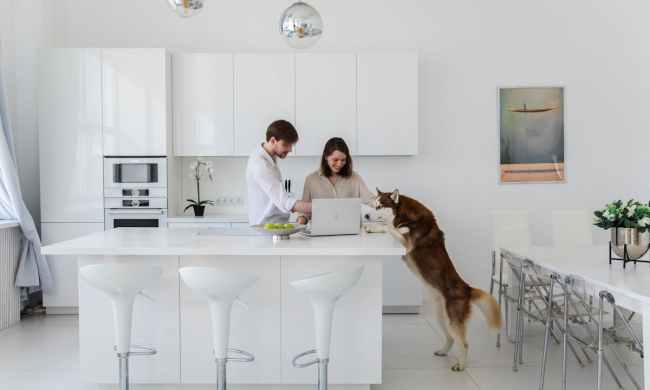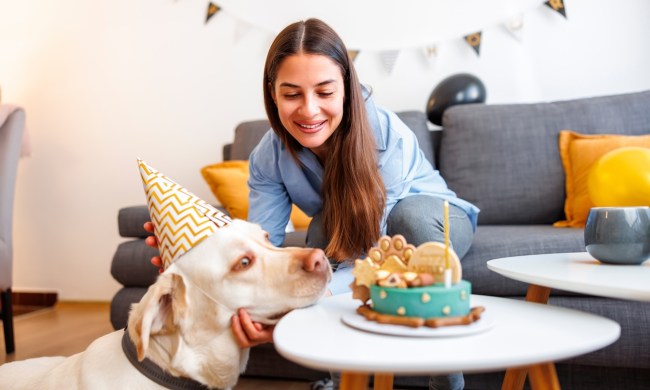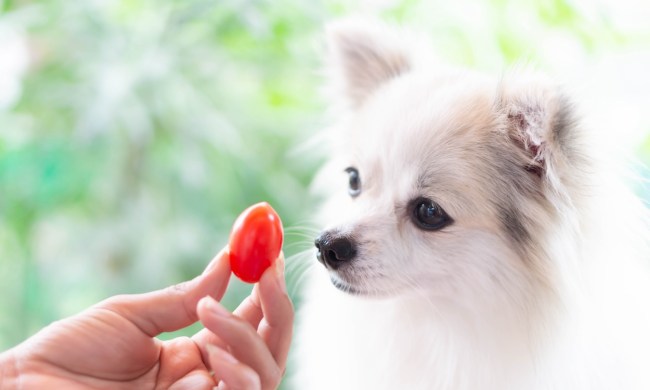The Lady and the Tramp movie photo has icon status. Pampered and temporarily displaced pooch Lady and free-wheeling terrier mix Tramp — the epitome of opposites — share a noodle and meet in the middle. Pasta must be a safe (even beloved) food for dogs, right?
Maybe. As you likely know, Disney isn’t always the best representation of reality. However, it would be nice to get invited to join a kingdom because you have the correct shoe size (Cinderella) or shoot icicles and learn you’re the fifth spirit (Frozen’s Elsa). Can dogs eat pasta safely in real life? As you’re likely also aware, some foods like chocolate are toxic for dogs. Others, like blueberries, serve as safe, low-calorie treats. Pasta is somewhere in the middle (right where Lady and Tramp met on their date). Here’s what to know about pasta safety for dogs.
Can dogs eat pasta? What pasta is safe for dogs?

Plain, cooked pasta is generally safe in small amounts. Served in this form, pasta isn’t toxic for dogs like chocolate or alcohol. Traditional pasta contains eggs, flour, and water, which aren’t unsafe. However, white pasta is a high and empty-calorie refined carbohydrate. Consuming too much white pasta can lead to unwanted weight gain.
Of course, there are many types of pasta other than the white noodles we’re used to consuming. For instance, health experts often recommend humans opt for whole-wheat pasta. This pasta is a complex carbohydrate, unlike white pasta. It contains fiber, manganese, selenium, copper, and phosphorous. These nutrients are beneficial for dogs, but they’re dose-dependent nutrients. That is, dogs would have to consume a ton of them to get the benefits. Plus, they’re already getting everything they need to thrive from their standard food, so dogs don’t need whole wheat pasta (or any pasta).
Lentil and chickpea foods are grain-free alternatives. Studies on whether grain-free diets can contribute to dog heart disease have produced mixed results. Your dog shouldn’t have these side effects from licking a lentil noodle off the floor, but you’ll want to avoid making this food a part of their regular diet.
Is cooked pasta safe for dogs?
Plain, cooked pasta is usually safe for dogs in moderation. However, certain common pasta seasonings, including garlic and onion, can pose health risks. Garlic and onions are often mixed into homemade and store-bought sauces, which frequently have high amounts of sodium. Excess salt can also be toxic for dogs. Other seasonings, like basil, are usually OK in small quantities.
Many dogs are lactose intolerant and may not do well with cheese (which is also high in salt and fat).
Signs that your has consumed something they shouldn’t include:
- Vomiting
- Diarrhea
- Lethargy
- Weakness
- Increased thirst
You can call your vet or ASPCA Poison Control at (888) 426-4435.
Can dogs eat raw pasta?
Dogs should not consume raw pasta. Raw pasta is a choking hazard. As you may imagine, uncooked pasta doesn’t go down easily and may cause temporary discomfort. If a dog eats too much raw pasta, it may cause GI tract blockage, which is a medical emergency. Signs your dog may have consumed raw pasta include:
- Vomiting
- Diarrhea
- Constipation
Chances are, your dog will be OK if they eat one raw elbow noodle that you dropped on the floor. However, watch them and call the vet if you notice signs that they’re in distress.
How much pasta can I give my dog?

The definition of “moderation” varies based on your dog’s size, breed, and experience with pasta. A Great Dane can consume more pasta than a Chihuahua. Your best bet is to follow the 90%-10% rule. Most (90%) of your dog’s daily calories should come from their standard food. The remaining 10% can come from low-calorie treats. Pasta doesn’t precisely fit that bill because it’s high in calories, so you’ll want to stick to tiny portions. If your dog has never had pasta, give them a little bite and monitor them for signs of distress.
What to do if your dog eats pasta

If your dog ate a little plain, cooked pasta, they will probably be OK. Many dogs will likely also be fine if they stole your pasta dinner (though they may have a tummy ache that night). However, if the pasta was seasoned with something toxic like garlic or onions, you’ll want to seek advice from a vet quickly. Call your vet, the nearest emergency vet, or ASPCA Poison Control at (888) 426-4435. A vet can give you the best information and advice for your dog based on their health, the pasta they consumed, what was on the pasta, and their symptoms.
Closing thoughts

Plain, uncooked white or whole grain pasta isn’t toxic for dogs. However, pasta is a high-calorie treat. Pasta prepared with onion, garlic, and high amounts of sodium (often in cheeses, butter, and sauces) can be toxic. Additionally, raw pasta can cause internal blockage and is a choking hazard. Your dog will likely be fine if they eat some cooked (or uncooked) pasta off the floor.
If you’re choosing to feed your dog cooked, plain pasta, stick to small bites and monitor them for distress. Remember, dogs get all the nutrients they need from their regular food, which should make up 90% of their daily calories. Call your pet’s vet or Poison Control if your dog consumed pasta (or anything) with garlic and onions.




